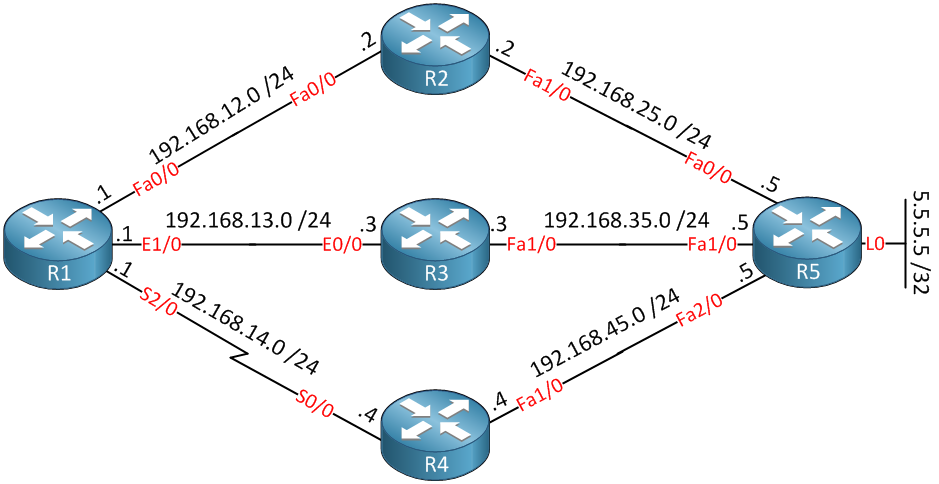This lesson demonstrates how to use the EIGRP variance command to load balance EIGRP over feasible successors. If you have no idea what I’m talking about then it’s best to read my lesson about EIGRP unequal load balancing first before you continue.
To demonstrate EIGRP load balancing, I will use the following topology:

The routers above are all running EIGRP. R1 is connected to R2, R3, and R4 using a FastEthernet, Ethernet, and Serial link. On the right side, you see R5 which has a loopback interface that is configured with network 5.5.5.5 /32. We will enable EIGRP on all interfaces and take a look at what path R1 will choose when we want to reach 5.5.5.5 /32.
Let’s enable EIGRP on all routers using the “shotgun approach”:
R1,R2,R3,R4 & R5:
(config)#router eigrp 1
(config-router)#no auto-summary
(config-router)#network 0.0.0.0If you are configuring this yourself, make sure you check that all routers have formed EIGRP neighbor adjacencies before you continue.
Let’s take a look to see what path R1 will choose to reach 5.5.5.5 /32:
R1#show ip route | begin 5.5.5.5
D 5.5.5.5 [90/158720] via 192.168.12.2, 00:00:04, FastEthernet0/0It will take the path through R2 which makes sense since this is the FastEthernet interface. If you want to see more detailed information, you can use the following command:
R1#show ip route 5.5.5.5
Routing entry for 5.5.5.5/32
Known via "eigrp 1", distance 90, metric 158720, type internal
Redistributing via eigrp 1
Last update from 192.168.12.2 on FastEthernet0/0, 00:00:07 ago
Routing Descriptor Blocks:
* 192.168.12.2, from 192.168.12.2, 00:00:07 ago, via FastEthernet0/0
Route metric is 158720, traffic share count is 1
Total delay is 5200 microseconds, minimum bandwidth is 100000 Kbit
Reliability 255/255, minimum MTU 1500 bytes
Loading 1/255, Hops 2To see exactly why R1 has selected R2 as the successor for this network, we’ll have to take a look at the EIGRP topology table:
R1#show ip eigrp topology 5.5.5.5 255.255.255.255
IP-EIGRP (AS 1): Topology entry for 5.5.5.5/32
State is Passive, Query origin flag is 1, 1 Successor(s), FD is 158720
Routing Descriptor Blocks:
192.168.12.2 (FastEthernet0/0), from 192.168.12.2, Send flag is 0x0
Composite metric is (158720/156160), Route is Internal
Vector metric:
Minimum bandwidth is 100000 Kbit
Total delay is 5200 microseconds
Reliability is 255/255
Load is 1/255
Minimum MTU is 1500
Hop count is 2
192.168.14.4 (Serial2/0), from 192.168.14.4, Send flag is 0x0
Composite metric is (2300416/156160), Route is Internal
Vector metric:
Minimum bandwidth is 1544 Kbit
Total delay is 25100 microseconds
Reliability is 255/255
Load is 1/255
Minimum MTU is 1500
Hop count is 2
192.168.13.3 (Ethernet1/0), from 192.168.13.3, Send flag is 0x0
Composite metric is (412160/156160), Route is Internal
Vector metric:
Minimum bandwidth is 10000 Kbit
Total delay is 6100 microseconds
Reliability is 255/255
Load is 1/255
Minimum MTU is 1500
Hop count is 2Above you see the different values for the feasible distance and advertised distance. The lowest feasible distance is 158.720, and it’s the path through R2 which makes it the successor.
R3 and R4 have been selected as feasible successors because their advertised distance of 156.160 is lower than the feasible distance (158.720) of R2.
So far, so good, we found the successor, and we know that R3 and R4 are feasible successors. If we want to enable load balancing, we have to use the following formula:
FD of feasible successor < FD of successor * multiplierSo the feasible distance of the feasible successor has to be lower than the feasible distance of the successor that is multiplied with some value. Let’s look at an example, so that this makes more sense. Let’s say we want to load balance over R3:
- Feasible Distance of R2 (successor) = 158720
- Feasible Distance of R3 (feasible successor) =412160
412160 / 158720 = 2.59So if I set the multiplier at something higher than 2.59, then R3 will be used for load balancing. The multiplier is configured using the variance command:
R1(config)#router eigrp 1
R1(config-router)#variance 3Let’s take a look at R1 to see if this has any effect:
R1#show ip route | begin 5.5.5.5
D 5.5.5.5 [90/412160] via 192.168.13.3, 00:00:42, Ethernet1/0
[90/158720] via 192.168.12.2, 00:00:42, FastEthernet0/0Above, you can see that R1 has installed the path through R3 as well. EIGRP does “unequal” cost load balancing, and to see how it shares traffic among the interfaces, we have to use another command:
R1#show ip route 5.5.5.5
Routing entry for 5.5.5.5/32
Known via "eigrp 1", distance 90, metric 158720, type internal
Redistributing via eigrp 1
Last update from 192.168.13.3 on Ethernet1/0, 00:00:40 ago
Routing Descriptor Blocks:
* 192.168.13.3, from 192.168.13.3, 00:00:40 ago, via Ethernet1/0
Route metric is 412160, traffic share count is 23
Total delay is 6100 microseconds, minimum bandwidth is 10000 Kbit
Reliability 255/255, minimum MTU 1500 bytes
Loading 1/255, Hops 2
192.168.12.2, from 192.168.12.2, 00:00:40 ago, via FastEthernet0/0
Route metric is 158720, traffic share count is 60
Total delay is 5200 microseconds, minimum bandwidth is 100000 Kbit
Reliability 255/255, minimum MTU 1500 bytes
Loading 1/255, Hops 2As you can see, EIGRP is sharing traffic in a 60:23 proportion, which means the FastEthernet link is used about 2.6 more often than the Ethernet link. What if we also want to use the serial link for load balancing? The feasible distance of R4 (2300416) is quite high. What kind of multiplier do we require to enable this link?



Great work. Keep it up …!!!
thnks…very very good explanation
Ultimate …awesome explanation
Thank you so much for this great blog
Good Job…
very precise explanation.
Thanks rene!